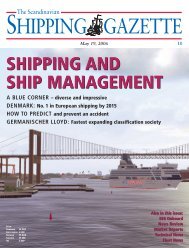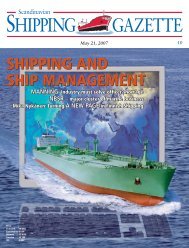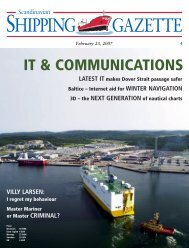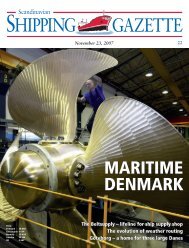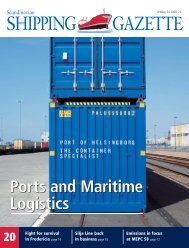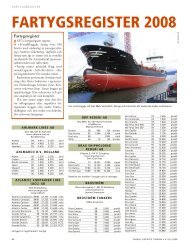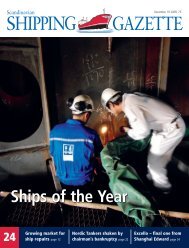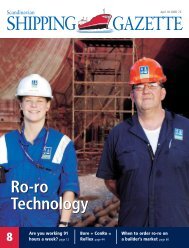SSG No 20 - Shipgaz
SSG No 20 - Shipgaz
SSG No 20 - Shipgaz
Create successful ePaper yourself
Turn your PDF publications into a flip-book with our unique Google optimized e-Paper software.
Ventspils, while products are shipped<br />
through Vysotsk, St Petersburg, Tallinn,<br />
Riga, Ventspils, Klaipeda and Kaliningrad.<br />
The eight European Union countries and<br />
Russia, all bordering in the Baltic Sea, are<br />
concerned by the potential environmental<br />
impact by spills and by the sheer volume<br />
of traffic. That is why they are working<br />
together within HELCOM co-operation<br />
for protecting the Baltic Sea.<br />
aframax volatility<br />
The bulk of <strong>No</strong>rthern European crude<br />
exports are carried in aframax size vessels.<br />
Exports to the US and Canada are also<br />
shipped in VLCCs and suezmax tankers.<br />
However, the most important type of crude<br />
tanker in <strong>No</strong>rth Europe is the aframax,<br />
which, as we noted earlier, has experienced<br />
an extremely volatile market, particularly<br />
in the past twelve months.<br />
At present there is too much aframax<br />
tonnage around at approximately 74.0<br />
million DWT, hence the freight volatility,<br />
which has caused owners some grief of<br />
late. With the volatile market at least in the<br />
past 18 months, it is important to see the<br />
<strong>No</strong>rth European market as part of a whole<br />
Atlantic market, including the Caribbean,<br />
the Mediterranean and the Black Sea. The<br />
inter-play between the markets is interesting,<br />
and we can see a certain “slush-effect”,<br />
as tonnage interchanges between the areas.<br />
time to weed out tonnage<br />
The transport bank DVB says in its latest<br />
market outlook for aframaxes that there are<br />
plenty of single hull vessels, which are up<br />
to their fifth special survey. Owners might<br />
choose to scrap at more than USD 500<br />
per light weight ton, or even find alternative<br />
employment as conversion to FPSOs.<br />
The bank also believes that high oil prices<br />
might provide more employment as more<br />
marginal fields come into production. DVB<br />
highlights healthy, long-term prospects for<br />
aframaxes by forecasting a demand growth<br />
of between six and seven per cent because<br />
of increasing trade to <strong>No</strong>rth America and<br />
Europe. All in all, the bank expects demand<br />
to be 26 per cent higher by <strong>20</strong>10 compared<br />
with <strong>20</strong>06.<br />
net fleet growth<br />
DVB estimates that the aframax fleet will<br />
have a net growth of nine per cent next<br />
year and eleven per cent in <strong>20</strong>09, and<br />
admits that this is likely to weigh down the<br />
market, before the conditions improves<br />
<strong>No</strong>rth European clean tanker rates <strong>20</strong>06–<strong>20</strong>07<br />
Worldscale � Clean MR, 37,000 tons, UKCont–TA<br />
� Clean, Baltic–UKCont, 30,000 tons<br />
� Clean, Baltic–TA, 65,000 tons<br />
400<br />
350<br />
300<br />
250<br />
<strong>20</strong>0<br />
150<br />
100<br />
Qt 1 ‘06<br />
2 ‘06<br />
when single-hull vessels are phased out<br />
from <strong>20</strong>10. The orderbook of more than<br />
ten million DWT in <strong>20</strong>09 will be particularly<br />
difficult to accommodate, and in<br />
<strong>20</strong>10 there are nearly seven million DWT<br />
on order. The bank also talks of the 150 or<br />
so coated aframaxes currently in the market<br />
and another 90 on order.<br />
the magical ws 100<br />
3 ‘06<br />
4 ‘06<br />
As we noted earlier owners work in an<br />
extremely volatile market. The worrying bit<br />
is when the market remains below WS 100<br />
1 ‘07<br />
2 ‘07<br />
<strong>No</strong>rth European dirty tanker rates <strong>20</strong>06–<strong>20</strong>07<br />
Worldscale<br />
350<br />
300<br />
250<br />
<strong>20</strong>0<br />
150<br />
100<br />
50<br />
Qt 1 ‘06<br />
2 ‘06<br />
3 ‘06<br />
4 ‘06<br />
1 ‘07<br />
3 ‘07<br />
4 ‘07<br />
Source: Scandinavian Shipping Gazette<br />
� Suexmax,135,000 tons, <strong>No</strong>rth Sea–TA<br />
� Aframax, 100,000 tons, Primorsk–UKCont<br />
� Aframax, 80,000 tons, NS–UKCont<br />
� Aframax, 100,000 tonnes, Murmansk–UKCont<br />
2 ‘07<br />
3 ‘07<br />
4 ‘07<br />
Source: Scandinavian Shipping Gazette<br />
in <strong>No</strong>rth Europe for any length of time.<br />
Except for the last two weeks of September<br />
the market has been lodged below the<br />
magical line since the beginning of August.<br />
There was another less profitable period<br />
in March this year and at the beginning<br />
of December last year. However, since the<br />
turn of the year, the cross <strong>No</strong>rth Sea market<br />
only reached WS <strong>20</strong>0 in one week in<br />
late January and once in late March. Since<br />
then the market has shown a falling trend<br />
(see graph).<br />
petter arentz<br />
SCAnDinAViAn SHiPPinG GAZETTE • OCTOBER 26, <strong>20</strong>07 23




